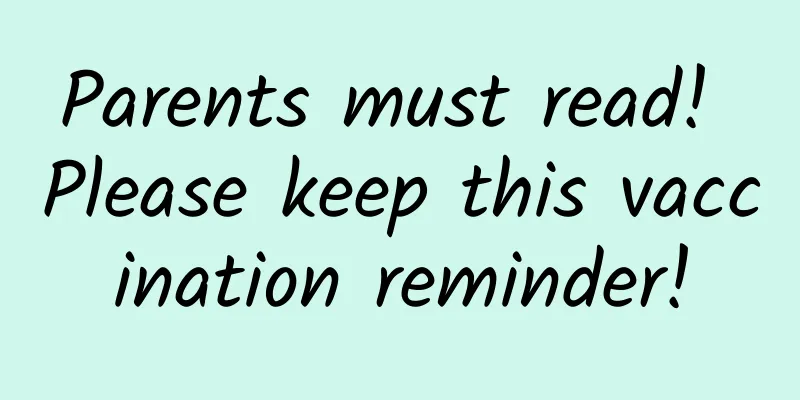Have you learned the trick of tapping your baby’s back to help him/her expel phlegm?

|
Author: Wang Zijuan Children's Hospital Affiliated to Chongqing Medical University Reviewer: Liu Yulin, Chief Nurse, Children's Hospital Affiliated to Chongqing Medical University Do parents have this kind of confusion: What should I do if my baby has phlegm in his throat and can't cough it out? I heard that I can tap the baby's back with my palms, but I'm worried that I will hurt the baby? What should I do if my baby has too much phlegm and can't cough it out? Sometimes, after finally coughing up some phlegm, the baby swallows it again. At this time, is our hard work of tapping the back in vain? Now, let's learn how to tap the back correctly to expel phlegm! Figure 1 Copyright image, no permission to reprint 1. Let us first understand what is back tapping to expel phlegm? Tapping the back to expel phlegm means rhythmically tapping the baby's back with your hands, using the principle of air vibration to remove secretions attached to the lungs and bronchi, preventing or improving phlegm stagnation in the airway, and then letting the baby cough to promote phlegm excretion from the body. Tapping the back can help babies expel phlegm and keep their airways open, preventing phlegm accumulation from causing pneumonia, atelectasis, etc. 2. Which babies can have back tapping? Situations in which back tapping is appropriate: Babies with thick sputum, weak sputum excretion, or excessive sputum secretion. 3. How to tap your baby’s back correctly? (1) The gesture should be correct: the palm should be in the shape of an "empty cup", that is, the fingers are together, the back of the hand is raised, and bent into a cup shape, so that the baby will not feel pain. Figure 2 Copyright image, no permission to reprint (2) The order should be correct: start from the baby's back, avoid the spine, use the wrist as a fulcrum, tap quickly and rhythmically from bottom to top, from outside to inside. If the baby's lesion is clear, you can focus on tapping the lesion side. Figure 3 Copyright image, no permission to reprint (3) Correct body position: Choose the appropriate body position according to the baby's situation. ① Sitting position: Babies who can sit steadily by themselves can sit in a sitting position, or parents can put one arm under the baby's armpit and let the baby lie on the arm to stabilize the baby's body, and tap with the other hand. ② Side-lying position: The baby lies on his side, and the parent taps the baby's back. ③ Vertical holding position: The parent holds the baby vertically, with the baby's lower jaw resting on the parent's shoulder. ④ Prone position: Babies who can lie on the bed by themselves can adopt this position. Figure 4 Copyright image, no permission to reprint Note: Some parents are afraid to use force when tapping their baby's back and tap very carefully, which makes it difficult to achieve the best results. In fact, as long as you avoid the shoulder blades and spine when tapping the back and keep your hands in an "empty cup" shape, you will not hurt the baby! (4) The timing must be correct: To prevent vomiting and spitting up caused by back tapping, the best time to do back tapping is 30 minutes before a meal or 2 hours after a meal. 4. What should I do if my baby swallows the phlegm he coughs up? Parents, don't worry. Although the phlegm is swallowed by the baby, it is not in vain. The phlegm goes from the respiratory tract to the digestive tract, so the phlegm in the respiratory tract is cleared, which is conducive to the elimination of respiratory inflammation. There are many digestive enzymes in the digestive tract that can digest and clear the phlegm, and the harm to the baby will disappear. [Tips] Parents can also help dilute sputum and promote sputum discharge by giving babies more warm water, mist inhalation, etc. If the sputum is really thick and needs medication, it must be used under the guidance of a doctor! |
>>: Constipation? Stubborn constipation? Don’t let constipation cause chronic damage to you!
Recommend
What are the dangers of masturbation during pregnancy?
Many women have a bad habit of masturbation. Ther...
How long does it take to check whether the uterus is ectopic?
After preparing for a long time, many mothers who...
What foods should we eat to maintain health during the Autumnal Equinox? What flowers are there during the Autumnal Equinox?
During the autumnal equinox, most parts of my cou...
How to store chrysanthemum tea? How to make chrysanthemum brain egg soup?
Chrysanthemum tea turns green after brewing, whic...
The oral ulcer is welded to my mouth, what should I do?
believe Many people have been troubled by oral ul...
Why is my period dark in color just two days after it started?
If the menstruation is abnormal, it should be che...
What is the cause of the pain in the breast?
Breast lumps (pimples) are usually caused by lesi...
Female urethral dilation pain video
What are the harms of urethral dilation? Urethral...
Picture of the process of breast development in women
The attachment to women's breasts is a charac...
The consequences of untreated pelvic effusion must be prevented!
Pelvic effusion is very harmful to women's he...
Precautions after taking the nine-valent vaccine
The nine-valent HPV vaccine is a major research a...
How much do you know about the cause of rhabdomyolysis?
This is the 4675th article of Da Yi Xiao Hu I rec...
Is it suitable for pregnant women to eat leeks?
When a girl is pregnant, her family will take goo...
What do you need to do to prepare for pregnancy?
Married couples need to do a pregnancy checkup be...









